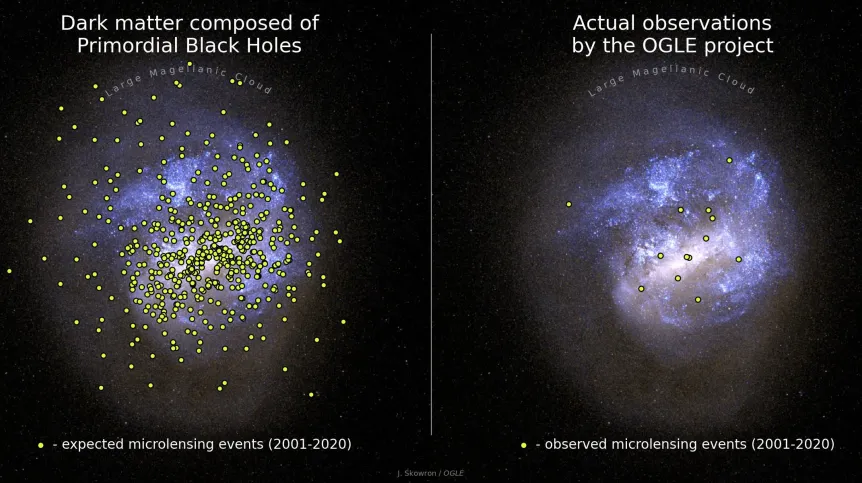
Black holes are not responsible for the creation of dark matter - according to the observations of Polish astronomers from the OGLE project, who have just presented the results of analyses of 20 years of observational data. They also report that primordial black holes cannot be the source of gravitational waves.
The research results were presented in two scientific publications. One appeared in Nature, the other in the Astrophysical Journal Supplement Series. They constitute a summary of the OGLE project's dark matter research.
Dark matter is a mysterious component of the cosmos, constituting about 5% of the total mass and energy of the Universe. It could be composed of unknown elementary particles, but its nature remains unknown. One hypothesis is that primordial black holes could account for at least some dark matter, and perhaps they are even detected by gravitational wave detectors such as LIGO and Virgo. The black holes detected by these detectors have significantly higher masses than those previously known in the Milky Way (20-100 solar masses compared to 5-20 solar masses).
'Explaining why these two populations of black holes are so different is one of the biggest mysteries of modern astronomy', says the first author of both publications, Dr. Przemek Mróz from the Astronomical Observatory at the University of Warsaw.
OGLE astronomers have presented the results of a nearly 20-year-long (2001 to 2020 the third and fourth phases of the OGLE project) monitoring of almost 80 million stars located in a nearby galaxy, called the Large Magellanic Cloud.
'This data set provides the longest, largest, and most accurate photometric observations of stars in the Large Magellanic Cloud in the history of modern astronomy', says Professor Andrzej Udalski, also from the university’s Astronomical Observatory.
The research focuses on searching for gravitational microlensing phenomena. This event results from Einstein's general theory of relativity. When a closer object (e.g. an invisible faint star or a black hole) and a more distant star are in the line of sight, the light from the distant star may be distorted. In the case of gravitational microlensing, this will be a characteristic temporary brightening as objects move relative to each other. The parameters of the phenomenon depend on the mass of the invisible object that causes the phenomenon; the greater the mass, the longer the phenomenon lasts. As a result, one can, for example, try to detect black holes this way.
According to the researchers, if all dark matter consisted of black holes with a mass of 10 solar masses, then - according to predictions - they should detect 258 gravitational microlensing events. If black holes were 100 solar masses each, then there should be 99 microlensing events, and for black holes with 1,000 solar masses each, there should be only 27.
Meanwhile, 13 such phenomena were found in the OGLE data. In addition, most of them lasted less than 100 days and were probably caused by normal stars in the Milky Way or the Large Magellanic Cloud.
'That indicates that massive black holes can compose at most a few percent of dark matter', explains Dr. Mróz.
The calculations demonstrate that black holes of 10 solar masses may comprise 1.2% of dark matter at most, 100 solar mass black holes - 3.0% of dark matter, and 1000 solar mass black holes - 11% of dark matter.
The scientists point to another important conclusion from the obtained results: black holes cannot be sources of gravitational waves. They suggest that it is more likely that the black holes detected by LIGO and Virgo were created as a result of the evolution of massive stars with low content of heavy elements, or the merger of smaller objects.
'That indicates that massive black holes can compose at most a few percent of dark matter', explains Dr. Przemek Mróz.
OGLE is one of the largest modern sky surveys. It has been conducting regular photometric observations for over 32 years. The project was created to search for gravitational microlensing phenomena, but the wealth of collected data also makes it possible to discover and study extrasolar planets, analyse the structure and evolution of the Milky Way, variable stars, quasars, novae, supernovae and other topics in astronomy.
The research team members are: Przemek Mróz, Andrzej Udalski, Michał K. Szymański, Igor Soszyński, Łukasz Wyrzykowski, Paweł Pietrukowicz, Szymon Kozłowski, Radosław Poleski, Jan Skowron, Dorota Skowron, Krzysztof Ulaczyk, Mariusz Gromadzki, Krzysztof Rybicki, Patryk Iwanek, Marcin Wrona, Milena Ratajczak, Mateusz Kapusta. (PAP)
PAP - Science in Poland
cza/ zan/ kap/
tr. RL













